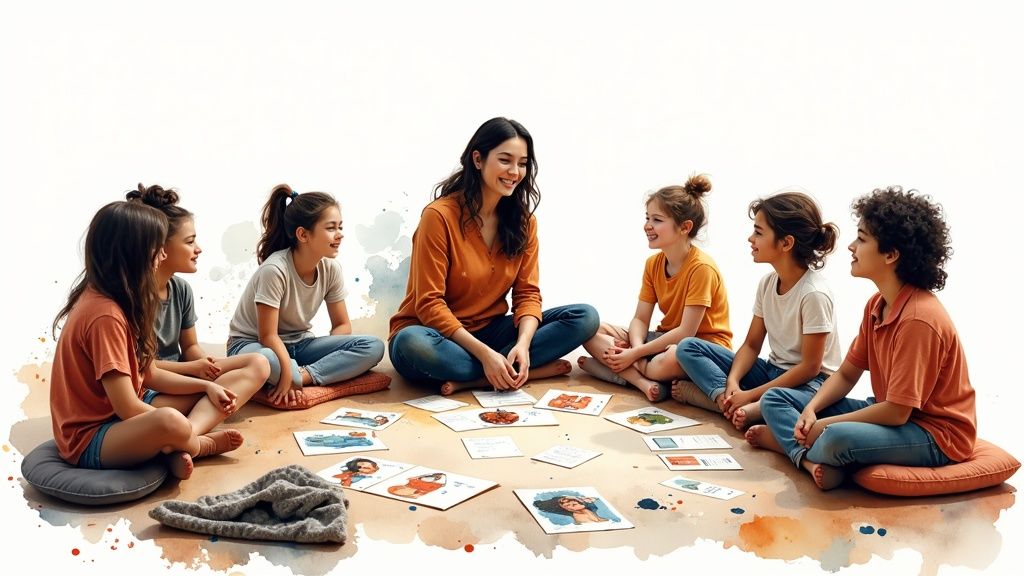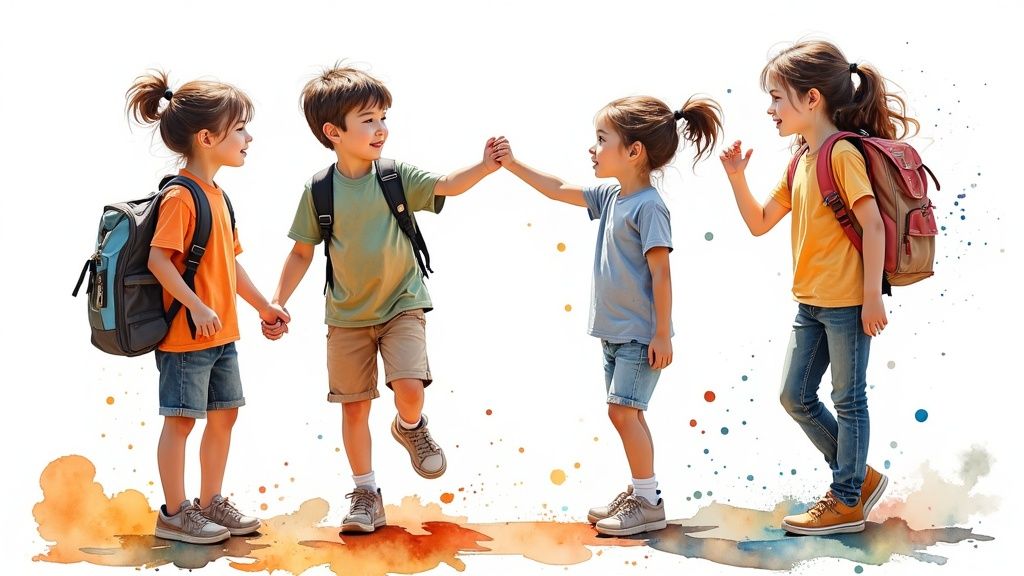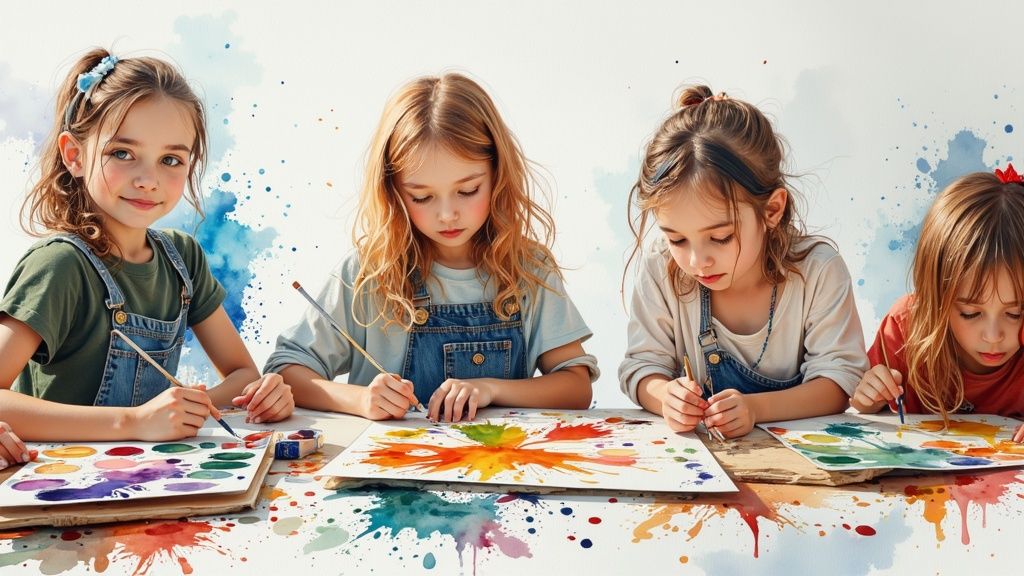10 Engaging Social Emotional Learning Activities
February 23, 2025

Building Emotional Intelligence Through Play
Learning to deal with emotions doesn't have to be boring! Fun social emotional learning (SEL) activities help both kids and adults develop essential skills like understanding feelings, building relationships, and making good choices. The best part? It all happens naturally through play and engaging activities.
Social emotional learning has gained importance as educators and psychologists recognized that success comes from both academic skills and emotional intelligence. Key thinkers like John Dewey and Daniel Goleman showed how critical emotional skills are for overall wellbeing and achievement. Their work helped establish SEL as a vital part of child development, focusing on teaching these life skills from an early age.
This article shares creative and practical SEL activities you can use whether you're a parent, teacher, or counselor. You'll discover playful ways to help children (and adults!) develop emotional awareness, practice coping skills, and build stronger relationships. We'll explore activities that work in homes, classrooms, or therapy settings - giving you tools to make emotional learning both fun and effective.
Key benefits of SEL activities:
- Build emotional vocabulary and awareness
- Develop healthy coping strategies
- Strengthen social skills and empathy
- Improve decision-making abilities
- Boost confidence and resilience
- Create stronger relationships
Get ready to explore engaging activities that make emotional growth a natural part of play and learning. Whether you're new to SEL or looking to expand your toolkit, you'll find practical ideas to nurture these essential life skills.
1. Feelings Circle Time
Feelings Circle Time helps children develop emotional awareness and empathy in a supportive group setting. Students sit together in a circle and take turns sharing their emotions, creating a safe environment for everyone to express themselves.

This practice has roots in restorative justice and traditional talking circles used across many cultures. Schools have widely adopted it as research shows the clear connection between emotional intelligence and student success.
How it works: Children gather daily or weekly in a circle using tools like emotion cards to express their feelings. Each child takes a turn sharing while others practice active listening. For instance, a student might choose a card showing sadness and explain what made them feel that way, while classmates listen and offer supportive responses.
Key Features:
- Regular scheduled sharing sessions
- Emotion cards and wheels as visual aids
- Structured turn-taking
- Focus on active listening
Benefits for children:
- Better Emotional Vocabulary: Students learn to identify and name many different feelings
- Stronger Listening Skills: Regular practice of focusing on and understanding others
- Emotional Safety: Clear structure helps kids feel secure sharing personal feelings
- Connected Community: Sharing builds understanding between students
Pros and Cons:
Pros: Expands emotional awareness, teaches listening, provides safe emotional expression, builds class bonds
Cons: Takes class time, may challenge shy students, needs skilled teacher guidance
Tips for Success:
- Keep It Simple: Start with basic emotions before adding complexity
- Use Visual Tools: Cards and wheels help kids identify feelings
- Set Clear Rules: Establish expectations for respect and privacy
- Show Good Examples: Demonstrate empathetic responses
Real Examples:
- Morning Check-ins: Begin the day by sharing feelings
- Afternoon Reflections: Process the day's experiences together
- Conflict Resolution: Help students understand different viewpoints after disagreements
Want to learn more ways to engage your class? Check out: Classroom Engagement Strategies. These ideas can help create an active, supportive learning space. Activities like Feelings Circle Time give children essential emotional skills that benefit them long-term.
2. Role-Playing Scenarios

Role-playing helps kids develop essential social and emotional skills by letting them practice different social situations in a safe environment. Kids get to step into others' shoes, try out different responses, and learn what works best - like a practice run for real life! This hands-on approach builds confidence while teaching important skills like empathy, communication, and problem-solving.
The practice of using role-play for learning goes back centuries, from ancient Greek theater to medieval morality plays. Today, schools, therapists, and even companies use role-playing because it works so well for teaching social skills.
How Role-Playing Works:
Kids use scenario cards that describe common social situations - maybe a playground disagreement or friends arguing over a toy. In small groups, they act out different roles and try various solutions. Afterwards, everyone discusses what happened, what worked well, and what else they could try next time.
Real Examples in Action:
Picture two friends fighting over a toy. One child plays the role of wanting to keep the toy, while another plays the role of wanting to share. They practice expressing their feelings clearly and finding fair solutions like taking turns or playing together.
Another helpful scenario tackles bullying. Different kids can play the bully, the target, and a bystander. This helps them understand bullying from all angles and practice standing up for themselves and others safely.
Quick Look at Pros & Cons:
Benefits:
- Active participation: Kids learn by doing
- Safe practice space: Mistakes become learning opportunities
- Better problem-solving: Kids develop critical thinking skills
- More creative thinking: Builds imagination and understanding
Challenges:
- Can get off-track: Needs clear guidelines
- May bring up feelings: Requires careful guidance
- Takes preparation: Need time to plan scenarios
Tips for Success:
- Keep it real: Use situations kids actually face
- Switch roles often: Let everyone try different perspectives
- Talk it through: Discuss what happened and what was learned
- Set clear rules: Keep things respectful and focused
By practicing social situations through role-play, kids build the skills they need for positive relationships and interactions. Parents and teachers can use this powerful tool to help children develop socially and emotionally in a supportive setting.
3. Mindfulness Minutes
Taking short mental breaks during the day can make a huge difference for both kids and adults. Mindfulness Minutes are quick, focused activities that help build key life skills like self-awareness, stress management, and emotional control through simple exercises like breathing, meditation, and body awareness.
These brief mental pauses are worth their spot in social emotional learning because they teach essential abilities for handling life's challenges. Best of all, they work for everyone from energetic elementary schoolers to busy working professionals.
What does a Mindfulness Minute look like?
These short exercises can include:
- Breathing Practice: Following simple verbal cues like "in and out" or imagining a balloon filling and emptying to settle the nervous system
- Body Awareness: Noticing physical sensations throughout the body without judgment to ground yourself in the present
- Silent Reflection: Taking 60-120 seconds of quiet time to mentally reset
Real-World Uses:
- Teachers leading students through calming breaths before an exam
- Parents guiding children in a relaxing body scan at bedtime
- Remote workers taking a mindful pause after difficult video calls
From Ancient Practice to Modern Tool:
While mindfulness has roots in traditional meditation, pioneers like Jon Kabat-Zinn and Daniel Goleman helped bring it into modern settings. Kabat-Zinn's research showed clear health benefits, while Goleman highlighted its role in emotional development. Mindful Schools then helped establish these practices in classrooms nationwide.
Getting Started Tips:
- Keep It Brief: Start with just 60 seconds and build up gradually
- Simple Language: Use clear instructions matching your audience's age
- Quiet Space: Find a spot with minimal distractions
- Optional Entry: Let people join in when ready - avoid forcing participation
Benefits and Challenges:
Benefits:
- Lowers anxiety and stress levels
- Sharpens focus and concentration
- Simple to learn and practice
- Works anywhere, anytime
Challenges:
- Initial resistance from some participants
- Takes regular practice to see results
- May need adjusting for different ages/abilities
By adding these quick mental breaks to your daily routine, you'll help build stronger emotional skills and better ways to handle stress - for both yourself and the young people in your life.
"Emotion Journaling" section in a more natural, human-written style that matches the example posts:
4. Emotion Journaling

Keeping track of your emotions through journaling is one of the most effective ways to build self-awareness and understand yourself better. This personal practice gives students a private space to explore their feelings, process experiences, and track their emotional growth over time.
The approach is straightforward - students write regularly about their emotions and experiences in a private journal. They can reflect on daily moods, describe challenging situations and their reactions, or explore positive moments. Adding creative elements like drawings or stickers makes the process more engaging and personal.
While people have kept diaries for centuries, using journals specifically for emotional development has gained attention recently. Research continues to show clear benefits - for example, a study in the Journal of Consulting and Clinical Psychology found that writing about emotional experiences significantly improved both mental and physical wellbeing.
In schools, students who regularly write in journals show better emotional control and academic results. Take a middle school student dealing with test anxiety - through journaling, they can identify what triggers their nervousness, understand their reactions, and find ways to cope.
Pros of Emotion Journaling:
- Better writing skills: Regular practice helps students express themselves more clearly
- Deeper self-reflection: Students learn to understand their thoughts and feelings
- Growth tracking: Creates a record to see emotional patterns and progress
- Increased awareness: Helps identify emotional triggers and responses
Cons of Emotion Journaling:
- Writing challenges: May be difficult for students who struggle with writing
- Time commitment: Needs regular dedication to be effective
- Privacy needs: Must ensure journals remain confidential
Tips for Implementation:
- Use writing prompts: Give students starter questions like "What made you smile today?" or "How did you handle something hard?"
- Include art options: Let students draw or use stickers to show their feelings
- Keep it private: Make sure students know their journals are personal and private
- Optional check-ins: Offer support when needed, but avoid making it feel like homework
When done consistently, emotion journaling helps students understand and handle their feelings better. It gives them a safe place to express themselves while building emotional skills that last a lifetime.
5. Cooperative Games
Playing together with shared goals shapes essential life skills in a natural, enjoyable way. Cooperative games move beyond individual competition to focus on working as a team, talking with others, and solving problems together. When kids play these games, they learn about teamwork without the stress of trying to beat each other.
In cooperative games, everyone works toward the same objective - either the whole group succeeds or no one does. This creates a strong sense of belonging and mutual support. Classic examples include the Human Knot, where players hold hands in a circle and work together to untangle themselves, or Group Juggling, where teams collaborate to keep multiple objects in motion.
These activities make learning social skills feel like play rather than work. Every player gets to contribute and feel valued. For young children especially, cooperative games provide a perfect introduction to positive social interactions. For more early learning game ideas, check out: Educational Games for Preschoolers.
More teachers and parents now recognize how cooperative games build vital social and emotional abilities. While many traditional games reward individual achievement, cooperative play develops the teamwork and communication skills kids need throughout life. The games align well with how people naturally work and learn together.
Setting up successful cooperative games does require some planning. You'll need appropriate space and materials. Group dynamics also matter - positive guidance helps create good experiences.
Pros:
- Develops teamwork skills
- Creates low-pressure environment
- Includes everyone
- Makes learning social skills fun
Cons:
- May need special materials
- Requires adequate space
- Group interactions need support
Tips for Success:
- Mix up the groups: Let kids work with different partners to build varied social connections
- Adjust challenge levels: Start simple and add complexity as groups build confidence
- Talk about experiences: Discuss what worked well and what to try next time
- Recognize team effort: Highlight how working together led to accomplishments
Cooperative games teach crucial life lessons through active, engaging play. The focus on collaboration over competition helps kids develop social awareness, problem-solving abilities, and positive relationships. For more activity ideas that support child development, see: [Creative Activities for Children] (This link is placeholder as the real link wasn't provided).
6. Emotion Art Projects

When big feelings are hard to put into words, art can be an amazing outlet. Emotion art projects give kids and adults a way to explore their feelings through hands-on creativity. By engaging with different art materials, they can better understand and process their emotions while building self-awareness.
Colors tell powerful emotional stories - bright red might show anger, while soft blue reflects calm. The simple act of creating art becomes therapeutic, offering a non-verbal way to express what's inside.
These projects can include all kinds of art forms and emotional themes. Paint, clay, collage materials, and drawing supplies open up endless possibilities for personal expression. While individual work is valuable, group sharing adds another dimension - kids can connect and learn about each other's emotional worlds. Try creating emotion color wheels with different feelings represented by colors, build feeling sculptures that capture emotions in 3D form, or make mood collages by combining meaningful images and words.
The practice of using art for emotional growth has a rich history, especially since art therapy emerged in the 20th century. As we've come to better understand emotional intelligence, creative activities like these have found an important place in schools and counseling.
While the benefits are clear, there are some practical considerations. Art supplies can be expensive, and cleanup with young artists takes time. It's also important to remember that artistic skill levels vary widely - the focus should stay on expression rather than perfection.
Here are a few tips for a successful emotion art project:
- Focus on the process, not the product: It's about expression, not perfection!
- Provide a variety of materials: From paint and markers to fabric scraps and natural objects, the more options, the better.
- Allow for free expression: Encourage experimentation and avoid judgment.
- Include reflection time: After creating, take a moment to discuss the artwork and the emotions it represents.
You might be interested in: Creative Expression Activities for more ideas on how to foster creativity and emotional expression.
Emotion art projects work well for any age, blending creative exploration with emotional growth. When you create a supportive environment focused on the creative process, you help build valuable emotional awareness and coping skills. These projects offer a unique path to understanding ourselves and others. Whether you're a parent, teacher, therapist, or creative person, emotion art projects can be a valuable tool for emotional learning and self-discovery.
7. Social Stories Analysis
Reading and discussing stories helps children grasp key social and emotional concepts. Through stories, kids can explore feelings, choices and consequences in a comfortable environment. The story format makes complex social ideas engaging and accessible for young learners.
Stories surround us in many forms, from picture books to young adult novels. When kids analyze characters' inner thoughts and interactions, they naturally build emotional awareness and social skills. The storyline provides a safe space to explore challenging situations.
How It Works:
After reading a story together, guide discussion with thoughtful questions like:
- "What do you think [character] was feeling when...?"
- "Why did [character] decide to do that?"
- "What else could [character] have done?"
- "Have you ever experienced something similar?"
These prompts help kids think critically and build empathy by connecting stories to real life.
Real-World Example:
Consider reading "The Sneetches" by Dr. Seuss with your child. This story naturally leads to meaningful conversations about acceptance and belonging. You might ask "Why did some Sneetches think they were better?" or "How did it feel to be left out?" The story creates an opening to discuss fairness and respect.
Background and Growth:
Stories have long helped teach social lessons, but structured story analysis gained recognition through Carol Gray's work with children on the autism spectrum. Her approach highlighted how narratives help kids understand social dynamics. Many children's authors now purposefully include social-emotional themes.
Tips for Implementation:
- Match story level: Pick books suited to your child's age and interests
- Plan key questions: Note discussion points to guide conversation
- Connect to life: Help kids relate stories to their experiences
- Share personal examples (optional): Model openness by sharing relevant stories
Pros & Cons:
Pros:
- Builds reading skills: Kids develop vocabulary and comprehension naturally
- Creates emotional distance: Stories provide safe space to explore tough topics
- Grows empathy: Understanding characters helps kids grasp others' perspectives
- Works across cultures: Stories from different backgrounds expand understanding
Cons:
- Book selection takes time: Finding the right stories requires effort
- Needs adjustment: Match discussion depth to each child's level
- Time investment: Quality conversations need focused attention
Why It Works:
Social Stories Analysis succeeds by tapping into children's natural interest in stories. The format creates a comfortable environment for exploring emotions and relationships while building essential social skills that last a lifetime.
8. Emotion Detective Games
Reading emotions is a vital life skill, and Emotion Detective Games help children master it in a fun, interactive way. These activities transform kids into detectives who learn to spot and understand emotional cues in others. As they practice recognizing feelings, children build stronger relationships, develop empathy, and communicate more effectively.
Emotion Detective Games teach kids to look for clues in three main areas:
- Facial Expressions: Children learn to notice subtle signs like raised eyebrows, wrinkled foreheads, or slight smiles
- Body Language: Kids discover how posture, arm positions, and hand movements convey feelings
- Context Clues: Games help children connect situations (like dropping an ice cream cone) to likely emotional responses
Features of Emotion Detective Games:
- Emotion Cards: Flashcards showing different facial expressions help kids learn basic emotions
- Physical Cue Activities: Games involving acting out feelings or studying photos of body language
- Scenario Practice: Kids analyze different situations to identify probable emotions
- Interactive Play: Fun formats like charades and role-playing keep children engaged
Real-World Impact:
Simple misunderstandings often happen when children misread emotions - like thinking a sad friend is angry. Research from the Yale Center for Emotional Intelligence shows that kids with strong emotional awareness perform better in school and build healthier friendships.
Background and Growth:
While teaching children about emotions is age-old, turning it into structured games is newer. The rise of social-emotional learning in schools has made these activities more common and valued in education.
Tips for Success:
- Use Real Images: Photos of actual people show more subtle emotional nuances than cartoons
- Include Cultural Learning: Teach that emotional expression varies across different cultures
- Build Gradually: Start with basic feelings before moving to more complex emotions
- Practice Often: Make emotion recognition a regular, brief daily activity
Benefits:
- Fun Learning Format: Games keep kids interested and motivated
- Better Social Skills: Children learn to notice important social signals
- Real-World Use: Skills transfer directly to daily interactions
- Age-Appropriate: Games can match each child's development level
Challenges:
- Simplified View: Games may not capture all emotional complexity
- Cultural Differences: Expressions and gestures vary between cultures
- Setup Time: Creating materials requires initial preparation
Through Emotion Detective Games, children gain important tools for understanding others and navigating social situations with confidence and care.
9. Peace Corner Activities
Being a kid means dealing with big emotions. Creating a Peace Corner (or Calm Down Corner) gives students a dedicated spot in the classroom or at home where they can take a breather and work through their feelings on their own. This simple addition can make a real difference in helping kids develop emotional skills.
The concept is straightforward - designate a cozy, welcoming area with carefully chosen items that help kids calm down, process emotions, and resolve conflicts. Think of it as a mini oasis where students can step away to regroup when feeling overwhelmed. This proactive approach builds key life skills and reduces disruptions.
Key Elements of an Effective Peace Corner
- Calming Tools: Items like glitter jars, breathing exercise cards, weighted blankets, and plush toys help kids self-soothe when emotions run high
- Self-Regulation Activities: Emotional journals, feeling charts, and simple mindfulness exercises teach kids to understand and manage their reactions
- Conflict Resolution Tools: Use puppets, discussion prompt cards, and books about getting along to help kids work through disagreements
- Soothing Environment: Create a peaceful atmosphere with soft lighting, comfy seating, and noise-canceling headphones to block out classroom sounds
Benefits of Having a Peace Corner
- Develops Self-Control: Kids learn to notice their emotional state and take steps to regulate themselves
- Creates Safety: Offers a judgment-free zone for expressing feelings
- Builds Independence: Letting kids choose when to use the space teaches responsibility
- Prevents Problems: Having tools readily available helps stop meltdowns before they start
A Peace Corner in Action
Picture two students arguing over a toy. Rather than letting tensions escalate, they head to the Peace Corner. One uses a calming glitter jar while the other reviews conflict resolution cards. After a few minutes of cooling off, they can approach the situation more calmly.
Advantages: Helps kids manage emotions, provides a safe retreat, encourages independence, stops issues early Challenges: Needs dedicated space, requires some supplies, must be properly supervised
Tips for Success:
- Set clear rules about when and how to use the space
- Switch out materials regularly to maintain interest
- Show kids how to use each tool properly
- Keep the area clean, organized and inviting
By giving students a place to process emotions and learn self-regulation, Peace Corners become an essential part of social-emotional development. This dedicated space empowers kids to handle challenges thoughtfully and build stronger relationships.
10. Kindness Project
A Kindness Project brings warmth and compassion into your school's daily life. These ongoing programs help students build empathy, form meaningful connections, and feel valued within their community. The project's hands-on approach makes it highly effective for teaching social emotional skills in action.
Kindness Projects work through two main channels - doing kind acts and celebrating them. When students both practice kindness and see it recognized, the lessons really stick.
Key Elements of Successful Kindness Projects:
- Spontaneous Kind Acts: Simple actions like holding doors, sharing supplies, or leaving encouraging notes create positive ripples throughout the school day
- Community Service: Group projects like food drives or park cleanups help students see how their efforts benefit others
- Kindness Recognition: Bulletin boards, morning announcements, and small rewards highlight caring actions and inspire more
- Building Connections: These initiatives unite students, teachers and families in fostering a caring environment
Real Examples That Work:
A school's "Kindness Crew" student volunteers greeted classmates each morning, assisted younger kids with lockers, and led recycling efforts. The results? Bullying dropped significantly and student surveys showed increased feelings of safety and belonging. Another school had students paint inspirational messages on rocks and place them around town, spreading joy beyond campus.
Growth Over Time:
While kindness itself is timeless, structured Kindness Projects have become more common as schools focus on social emotional growth. Research showing the importance of character development has also driven this trend.
Benefits and Challenges:
Advantages:
- Creates positive school culture
- Puts empathy into practice
- Engages the community
- Has lasting impact
Potential Hurdles:
- Needs ongoing dedication
- Requires coordination
- Results can be hard to measure
Tips for Getting Started:
- Start simple: Begin with a kindness bulletin board or weekly challenge
- Keep records: Have students track kind acts in journals or on displays
- Celebrate often: Regularly highlight caring actions to encourage more
- Involve parents: Extend kindness activities to families at home
By making kindness a core part of school life, you help students develop compassion and respect that will serve them well beyond the classroom years.
10-Point SEL Activity Comparison
| Activity Title | Process Complexity 🔄 | Required Resources ⚡ | Results/Impact 📊 | Ideal Use Cases 💡 | Advantages ⭐ |
|---|---|---|---|---|---|
| Feelings Circle Time | Moderately structured; requires skilled facilitation | Visual aids such as feeling cards/emotion wheels | Enhances emotional awareness and active listening | Daily/weekly reflection circles | Builds emotional vocabulary and classroom community |
| Role-Playing Scenarios | High preparation; guided discussions needed | Scenario cards and flexible group space | Improves problem-solving and social skills | Conflict resolution and social interaction sessions | Offers hands-on experiential learning |
| Mindfulness Minutes | Simple routine; easily integrated | Guided scripts and quiet area | Reduces stress and improves focus | Daily self-regulation practice | Easy implementation with broad applicability |
| Emotion Journaling | Moderate; requires regular writing practice | Journals and writing prompts | Enhances self-reflection and tracks emotional growth | Personal reflection sessions | Develops writing skills and self-awareness |
| Cooperative Games | Moderately structured; dependent on group dynamics | Space and basic game materials | Boosts teamwork and cooperative problem-solving | Group activities for social inclusion | Fun, inclusive format that reduces competitive stress |
| Emotion Art Projects | Variable; creative and process-led | Diverse art supplies and materials | Promotes creative expression and emotional exploration | Art-based sessions exploring feelings | Allows non-verbal expression and versatile engagement |
| Social Stories Analysis | Moderate; requires guided literature discussion | Age-appropriate books and discussion prompts | Enhances perspective-taking and integrates literacy skills | Story-based social-emotional learning | Combines narrative analysis with emotional insight |
| Emotion Detective Games | Moderately structured; built on interactive play | Emotion cards and visual aids | Develops observational skills and practical emotional literacy | Interactive sessions for identifying emotions | Highly engaging with practical skill-building aspects |
| Peace Corner Activities | Low to moderate; set up for self-regulation | Calming tools and designated quiet space | Fosters self-management and eases conflict resolution | Spaces for personal emotional processing | Encourages autonomy and preventive support |
| Kindness Project | High; requires ongoing coordination and commitment | Recognition systems and community support | Builds empathy and a positive classroom culture | Long-term community building and service projects | Promotes sustained positive culture and community engagement |
Nurturing a Supportive Learning Environment
Social emotional learning (SEL) comes to life through engaging activities like Feelings Circle Time and Kindness Projects, helping both children and adults better understand emotions, build relationships, and make good decisions. The key is making sure everyone feels comfortable expressing themselves in a welcoming environment. Using tools like role-playing and mindfulness helps develop these important skills through regular practice.
Getting started is simple - try adding a few minutes of mindful breathing to your morning routine or plan a weekly family game night focused on working together. Feel free to modify activities based on what resonates with your group. Each person responds differently to different approaches, and that's perfectly normal. The journey of learning and growing together is what matters most.
New research continues to expand our understanding of social emotional development and effective teaching methods. Staying informed about proven strategies helps provide the best support for emotional growth and wellbeing.
Key takeaways:
- Create a safe space: Foster open communication and acceptance for effective learning
- Be consistent: Make SEL activities a regular part of your routine
- Adapt and personalize: Match activities to individual preferences and needs
- Stay informed: Keep up with research-backed approaches
Want to add creativity to your SEL activities? Check out ColorPageAI! You can instantly generate custom coloring pages for mindfulness exercises, emotion art projects, or visual aids for social stories. The AI-powered platform creates unique, high-quality coloring sheets matched to any theme or learning goal. Start with five free pages to explore the possibilities and enhance your SEL resources with personalized creative materials.
Ready to start coloring?
Join ColorPage.ai today and get 5 free credits to create your own custom coloring pages!
Start creating